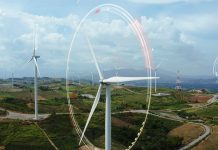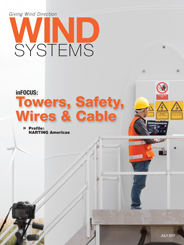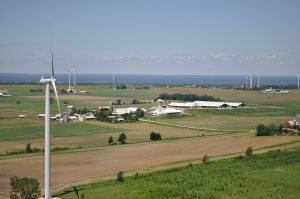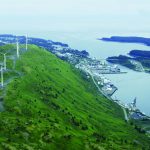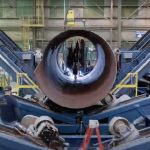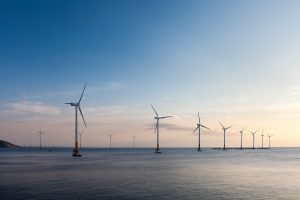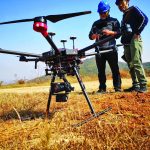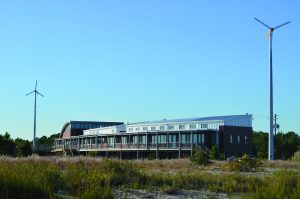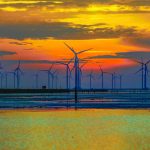There was a lot to take in at this year’s WINDPOWER show in Anaheim, California, sponsored by the American Wind Energy Association.
Hundreds of exhibitors running the gamut from manufacturers to O&M to drone services to power distributors were on hand to proudly display what they bring to the table in the ever-expanding wind industry.
It also served as an opportunity for many industry leaders to have a platform to speak directly to those most affected by current events and future endeavors.
The three-day event featured panel discussions and speeches from key players that included AWEA CEO Tom Kiernan; Tristan Grimbert, president and CEO of EDF Renewable Energy; Chris Brown, president of Vestas Americas; and Pete McCabe, president and CEO of GE Renewable Energy’s Onshore Wind.
Despite some caveats that stemmed from the current political climate, the overall message was positive.
Kiernan said there were more than 100,000 jobs in wind in 2016, and that the industry is hiring veterans 50 percent faster than the national average. And a whole new area in wind for the U.S. opened up when the first offshore wind farm began operations off the coast of Rhode Island near the end of 2016.
With those opportunities, corporations such as Amazon and Tide are helping lead the way by making commitments to use clean, renewable energy to power their factories and offices, according to Kiernan.

Staying the Course
Brown emphasized the difference in the last year, transforming from setting the course to staying the course.
“I said that we were on the right side of history,” he said. “While wind continues to compete on price, the hardest decision we made was to accept as an industry the PTC stays down. It was a bold, visionary decision based on a belief that we could compete on a level playing field, and we could compete on cost. That took courage. And I’m here today to tell you we need to stay that course. The last 12 record-breaking months have proved that we are delivering on that fundamental proposition of our vision of low-cost power for the consumers.”
Brown added that even though some in the industry may be feeling a little fear in the unknown, that fear is healthy.
“If you’re feeling that fear, then good — welcome to life as an energy disruptor,” he said.
And as the grid becomes more and more stable as wind energy grows, the industry attracts critics, according to Brown.
“Why do those critics pay attention to us?” he asked. “Because we’re a threat. Because we’re winning.”
Kevin de Leon, president pro tempore of the California State Senate, lauded his state’s strides at being a pioneer in the wind industry as it continues to lead the way for renewable energy.
“California is a model for the rest of the world,” he said.
Ben Fowke, president and CEO of Xcel, said that wind has steadily improved over the last 10 years.
And although for many, the environment plays a factor in investing in wind, it’s also about the bottom line.
“For our customers who are economically driven, it’s about money,” he said. “Wind is a fuel that is saving them money.”

(Courtesy: Kenneth Carter)
Industry Influences
Renee Carlson, procurement manager for global energy with 3M Corporation, said the industry is changing the way her company buys energy.
Amy Francetic, SVP of new ventures and corporate affairs for Invenergy, mirrored that statement.
“Wind is the largest part of our portfolio,” she said. “We have developed and have in construction 15 GW of power, and that’s across wind, solar, battery storage, and natural gas, and it’s really important to us to try to always site our projects and determine our contracts so we can deliver the lowest possible price but also get really terrific efficiency from the equipment, so there’s been a lot of amazing improvements in the equipment to get better and better efficiency. And there’s a lot of opportunity as a developer and an owner/operator to make sure that we’re managing those assets as capably as possible, so we can deliver reliability and security and affordability to customers.”
And many industry experts expect technology to play a hand in that.
“The markets are designed for competitiveness,” Francetic said. “So let’s let the markets do their thing. And the older assets need to retire, as it’s too costly to keep them online and keep them clean. Especially when you have such affordable resources now coming online. And we’re really excited about a lot of new solutions. We don’t have any offshore wind, but I’m personally really excited to see offshore wind happen. And I think there are going to be remarkable advances in the technologies around turbine design, around transmission on offshore wind, and that’s going to benefit onshore, so this is an exciting time to be in renewables.”
Opportunity
If there was any doubt in wind’s future, it did not make an appearance during WINDPOWER’s sessions or among the hundreds of industry businesses proudly displaying their talents and resources on the show floor. Industry leaders continued to boast their pride and enthusiasm about wind’s future, especially during the next five years.
“Our future is not about fear; it’s about opportunity,” Brown said. “The next five years of this industry aren’t going to be the end of the industry. They’re going to be the best five years of your life.”


















